This comprehensive answer handles writing out:
- The
Data collection property found on all exceptions (The accepted answer does not do this).
- Any other custom properties added to the exception.
- Recursively writes out the
InnerException (The accepted answer does not do this).
- Writes out the collection of exceptions contained within the
AggregateException.
It also writes out the properties of the exceptions in a nicer order. It's using C# 6.0 but should be very easy for you to convert to older versions if necessary.
public static class ExceptionExtensions
{
public static string ToDetailedString(this Exception exception)
{
if (exception == null)
{
throw new ArgumentNullException(nameof(exception));
}
return ToDetailedString(exception, ExceptionOptions.Default);
}
public static string ToDetailedString(this Exception exception, ExceptionOptions options)
{
var stringBuilder = new StringBuilder();
AppendValue(stringBuilder, "Type", exception.GetType().FullName, options);
foreach (PropertyInfo property in exception
.GetType()
.GetProperties()
.OrderByDescending(x => string.Equals(x.Name, nameof(exception.Message), StringComparison.Ordinal))
.ThenByDescending(x => string.Equals(x.Name, nameof(exception.Source), StringComparison.Ordinal))
.ThenBy(x => string.Equals(x.Name, nameof(exception.InnerException), StringComparison.Ordinal))
.ThenBy(x => string.Equals(x.Name, nameof(AggregateException.InnerExceptions), StringComparison.Ordinal)))
{
var value = property.GetValue(exception, null);
if (value == null && options.OmitNullProperties)
{
if (options.OmitNullProperties)
{
continue;
}
else
{
value = string.Empty;
}
}
AppendValue(stringBuilder, property.Name, value, options);
}
return stringBuilder.ToString().TrimEnd('\r', '\n');
}
private static void AppendCollection(
StringBuilder stringBuilder,
string propertyName,
IEnumerable collection,
ExceptionOptions options)
{
stringBuilder.AppendLine($"{options.Indent}{propertyName} =");
var innerOptions = new ExceptionOptions(options, options.CurrentIndentLevel + 1);
var i = 0;
foreach (var item in collection)
{
var innerPropertyName = $"[{i}]";
if (item is Exception)
{
var innerException = (Exception)item;
AppendException(
stringBuilder,
innerPropertyName,
innerException,
innerOptions);
}
else
{
AppendValue(
stringBuilder,
innerPropertyName,
item,
innerOptions);
}
++i;
}
}
private static void AppendException(
StringBuilder stringBuilder,
string propertyName,
Exception exception,
ExceptionOptions options)
{
var innerExceptionString = ToDetailedString(
exception,
new ExceptionOptions(options, options.CurrentIndentLevel + 1));
stringBuilder.AppendLine($"{options.Indent}{propertyName} =");
stringBuilder.AppendLine(innerExceptionString);
}
private static string IndentString(string value, ExceptionOptions options)
{
return value.Replace(Environment.NewLine, Environment.NewLine + options.Indent);
}
private static void AppendValue(
StringBuilder stringBuilder,
string propertyName,
object value,
ExceptionOptions options)
{
if (value is DictionaryEntry)
{
DictionaryEntry dictionaryEntry = (DictionaryEntry)value;
stringBuilder.AppendLine($"{options.Indent}{propertyName} = {dictionaryEntry.Key} : {dictionaryEntry.Value}");
}
else if (value is Exception)
{
var innerException = (Exception)value;
AppendException(
stringBuilder,
propertyName,
innerException,
options);
}
else if (value is IEnumerable && !(value is string))
{
var collection = (IEnumerable)value;
if (collection.GetEnumerator().MoveNext())
{
AppendCollection(
stringBuilder,
propertyName,
collection,
options);
}
}
else
{
stringBuilder.AppendLine($"{options.Indent}{propertyName} = {value}");
}
}
}
public struct ExceptionOptions
{
public static readonly ExceptionOptions Default = new ExceptionOptions()
{
CurrentIndentLevel = 0,
IndentSpaces = 4,
OmitNullProperties = true
};
internal ExceptionOptions(ExceptionOptions options, int currentIndent)
{
this.CurrentIndentLevel = currentIndent;
this.IndentSpaces = options.IndentSpaces;
this.OmitNullProperties = options.OmitNullProperties;
}
internal string Indent { get { return new string(' ', this.IndentSpaces * this.CurrentIndentLevel); } }
internal int CurrentIndentLevel { get; set; }
public int IndentSpaces { get; set; }
public bool OmitNullProperties { get; set; }
}
Top Tip - Logging Exceptions
Most people will be using this code for logging. Consider using Serilog with my Serilog.Exceptions NuGet package which also logs all properties of an exception but does it faster and without reflection in the majority of cases. Serilog is a very advanced logging framework which is all the rage at the time of writing.
Top Tip - Human Readable Stack Traces
You can use the Ben.Demystifier NuGet package to get human readable stack traces for your exceptions or the serilog-enrichers-demystify NuGet package if you are using Serilog. If you are using .NET Core 2.1, then this feature comes built in.

